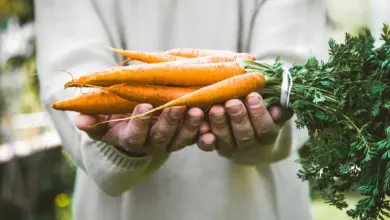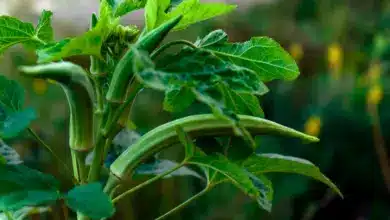Ever wondered how I grow eggplant? It’s a great warm-season vegetable that will make you happy to eat. Plus, its beautiful purple flowers and fruit add a lot of interest to your garden. If you have ever grown tomatoes or peppers, then you are already on the right track. But don’t worry if this is your first time. Here’s what you need to grow eggplants in your garden.
Fruits are available in all shades and colors of purple. Some varieties have white streaks. Others are white, or even green, when mature. The fruit can come in different shapes, including egg-shaped, round or long and thin, as well as curved. You can have so much fun watching the plants grow. You can bake, roast, grill, pan-sear or fry eggplant in the kitchen. Home-grown ingredients make a delicious eggplant parmesan.
It is easier to grow eggplant in warmer climates, but it can be successful in colder climates as well with some extra care. Both eggplant and tomatoes are nightshades and therefore share some of the same pests and diseases. Don’t let this discourage you from growing the eggplant. It is really a delight.
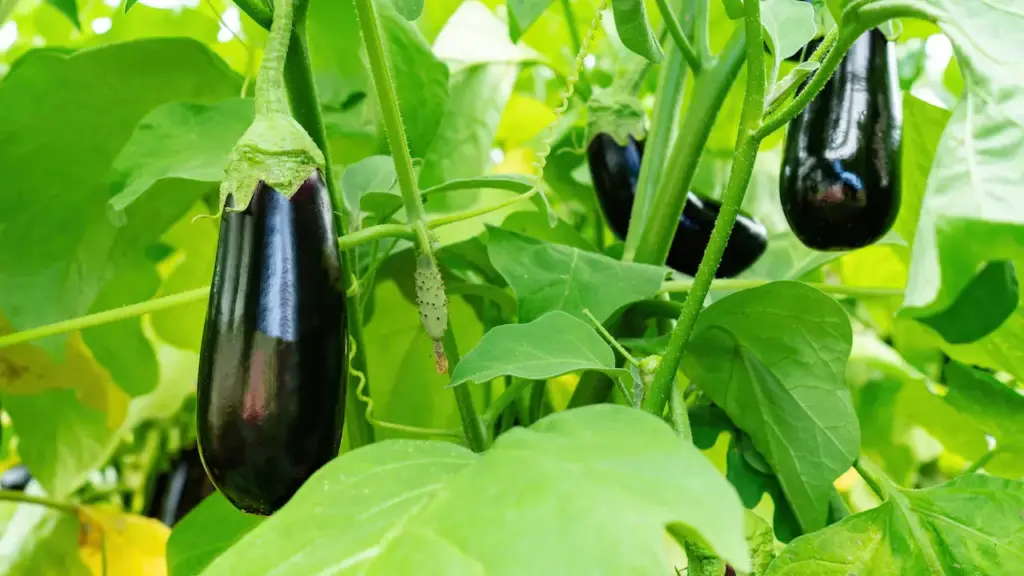
Eggplant Pests and Diseases
The flea-beetle is without a doubt the most common pest on eggplant. These are small jumping leaf beetles that can be black or bronze in color and measure only an eighth inch. These pests are fast and can chew tiny holes in the leaves. The leaves of the plants are more vulnerable to attack while they are still young and tender. By the summer, plants are big enough and strong to withstand flea beetle attacks.
Row cover is the best way to protect your plants. Cover them as soon as you plant them. It is available at many garden centers, and online. You can also plant a trap of radishes. Flea beetles will prefer them over eggplant.
- Aphids sucking insects are vectors of plant diseases. They excrete honeydew as they consume plant leaves, which attracts other insects and ants. You can easily control them by sprinkling a stream of water on the plants.
- Fruitworms, armyworms and moth larvae bore into the fruits themselves of eggplants. Pick off caterpillars that are green, black, or gray. Bt works organically to control moths and butterflies larvae. It is safe for humans, pets and other wildlife. Be sure to avoid applying it near plants that host butterfly larvae, such as milkweed or fennel.
- In terms of disease, verticillium worr is most prevalent. This is a fungus that lives in the soil. The best way to prevent wilt is by using a compost-rich soil and premium-potting mixture in containers.
- Anthracnose can be found on overripe or ripe fruits. It appears as small, flattened areas, which grow larger with time. Infected fruits should not be left in the garden as they can easily spread the fungus to other fruit or soil.
- Phytophthora blight includes small to large leaf spots as well as fruit rot and crown rot. Avoid overwatering as the fungus will thrive in soils that are saturated with water. Do not compost the plants affected by the blight. Remove any leaves and debris from your garden.
When, where and how to plant eggplant
After the last frost date, you can plant eggplant seedlings outdoors. Wait until temperatures overnight are consistently over 60deg Fahrenheit. Eggplants hate cold.
The first day, you should expose the seedlings to the sun for about 30 minutes. Each day, increase this time by a few minutes.
Plant eggplant seedlings at a location that receives between 6 and 8 hours of direct sun daily. The soil must be well-draining and should have plenty of compost added.
The best soil for growing eggplant is between pH 5.5-7.0. This range covers soils that are slightly acidic up to neutral. A soil test can help you to eliminate any guesswork. Adding compost helps bring the pH back into balance. Test results will show the pH of the soil and its nutrient content, so you can decide what changes to make.
Eggplant likes soil that is at least 70 degrees. In the South this shouldn’t pose a problem, but in northern areas you might need to use this trick to increase the soil temperature. Cover the area in black plastic a few weeks before planting and allow it to absorb solar energy. Leave the plastic on the surface, but cut slits to allow you to plant the seedlings. Backfill the hole with the soil you dug up, but be careful not to bury the stem.
Before transplanting, remove any fruits or flowers so that the plant can focus its energy on developing roots and stems and adapting to the outdoor environment. It will produce more flowers and fruit in warmer temperatures, as the plant’s foundation is stronger. The final yield will be higher.
Follow the instructions on the seed package to space eggplant seedlings. Install a stake, or tomato cages at the time of transplanting or shortly after. It is risky to add supports after plants are grown because they may suffer stem and root damage.
Cover the soil with two to three inches organic mulch like wheat straw. Mulch retains moisture and keeps the soil warm during cool nights.
Covering the garden with floating row cover like Reemay will keep eggplant seedlings warm. You can leave the cover up until summer arrives, but adjust it when the plants get taller. The self-pollinating nature of eggplants means that the cover does not need to be removed to allow pollinating insects to access.
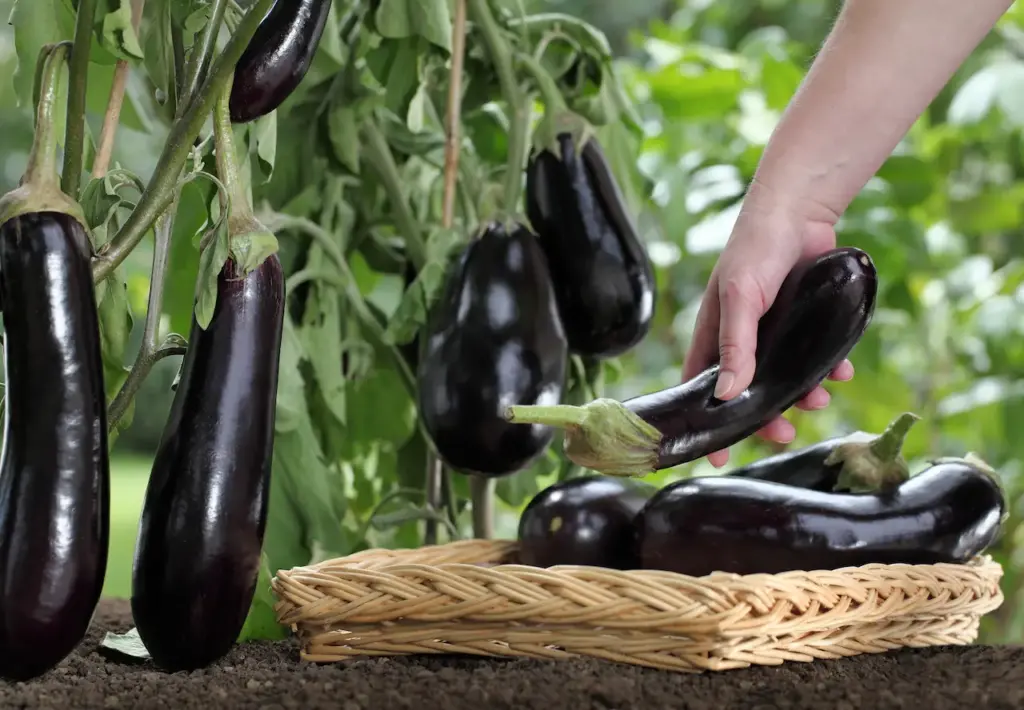
Eggplants: When and how to start them
Eggplants can be purchased as seedlings, or you can start them from seeds indoors 4 to 8 weeks before your last frost date. Seedlings are easier to buy, but they cost more and have less selection than seeds.
In small pots, plant eggplant seeds about a quarter inch deep in sterile seed starting mix. The plants are susceptible to transplant shock so do not start them in flats.
Use a thermostat-controlled seedling heat mat to maintain a soil temperature of between 75deg and 90degF. The seeds will germinate within a week if you maintain the soil temperature between 75deg and 90degF.
Start eggplant seeds under grow lights. Seeds do not need light to germinate. However, once they emerge, the seedlings will stretch and become weak and leggy as they reach for the light. Seedlings that are grown under a grow light will have shorter and stronger stems. A fan can be used to prevent damping-off disease. This fungus is deadly for seedlings, even before they have their first leaves.
The seedlings should be “potted-up” into larger containers as they grow. It’s time to move up the pot when seedlings reach 4 inches.
Variety of Eggplant
Solanum melongena is the species that includes all eggplant varieties, also called aubergine or brinjal in other parts of the world.
- Black Beauty has large dark purple fruits. It is an heirloom eggplant. The plants reach a height of 18-24 inches and the fruit is ready for harvesting 74 days after planting.
- Galine has proven to be a very reliable and productive variety for the North. It is a hybrid that produces “black bell” fruits that reach 6-7 inches. It matures within 65 days.
- Green Knight produces jade-green, long fruits with dense flesh. This hybrid variety is 34-36 inches high with 7-inch fruits.
- Listada De Gandia has a European heirloom. It grows up to 14 inches tall and produces purple and white streaked fruits that are shaped like small eggs. The fruit is mildly flavored and the skin is thin and tender. It matures between 80 and 90 days.
- Michal grows well in high tunnels or greenhouses. The fruit is black and tasty, with few seeds. It matures in 60-75 days.
- Pot Black has compact plants with 3-ounce fruits without bitter taste. The days to maturity is only 58-62.
- Purple Blaze produces attractive purple fruits with white streaks. The plants reach a height of 18-20 inches. The white inside of the 4-inch fruits is visible.
- Ping Tung Long, an open-pollinated variety of eggplant, matures within 65 days. This is a good pickling eggplant, with bright purple, glossy fruit. It grows best when 9 inches long and slightly curved.
- White Star Hybrid produces sweet, shiny white fruit. It is not bitter like some purple varieties. The plants reach a height of 30-36 inches and the fruits are 5-7 inches in length.
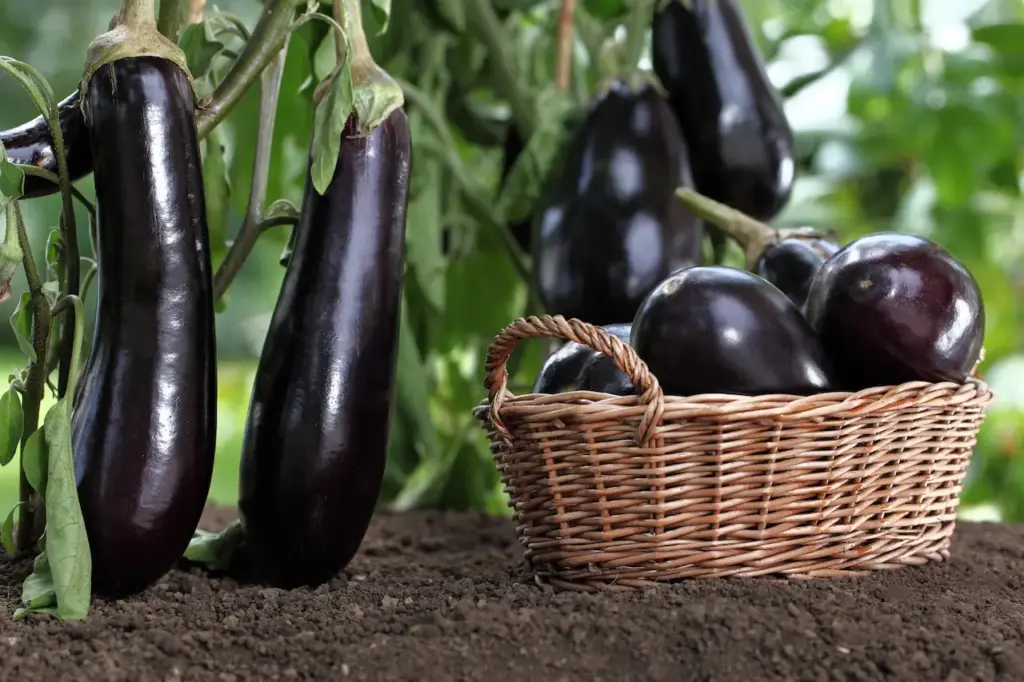
Fertilizing Eggplant
Add well-rotted compost to the planting area, a few weeks before you plant the eggplant seeds. This will provide them with the majority of nutrients they need. Use blood meal or cottonseed at planting time.
As the plants grow, you can spray organic foliar fertiliser on them. Follow the directions provided by the product. (More does not equal better.) Use fertilizers that are balanced in nitrogen and phosphorus or have a lower nitrogen content than phosphorus. If you use a high-nitrogen fertiliser, it will promote foliar growth and reduce fruit production.
Do not exceed the instructions of the manufacturer. Over-fertilizing is not better.
Watering Eggplant
The plants that do not receive enough water produce small, bitter fruits. Water your eggplants at least one inch per week and as much as two inches in the hotter months of summer. If there has been less than one inch of rain in a given week, you can make up for the lack with additional irrigation.
Water the ground at the same level as your foliage. Watering from above can cause disease to the foliage and fruit.
Growing eggplant is easy with a drip irrigation system. This will protect seedlings and mature plants from being soaked by water.
Harvesting Eggplant
You should note the variety and size of your eggplants at maturity to determine when to harvest. The majority of eggplants can be harvested when they are half-way mature. The smallest fruits have the best taste, and the more you pick them the more the plant will produce.
Do not pull the fruit off the plant. Instead, carefully cut it off. Fruit is best eaten immediatel


